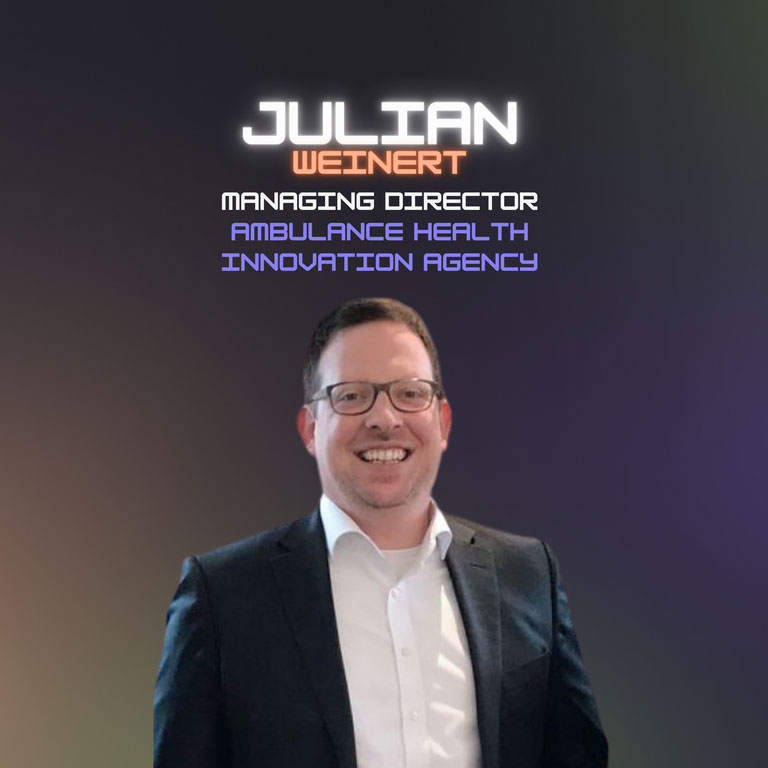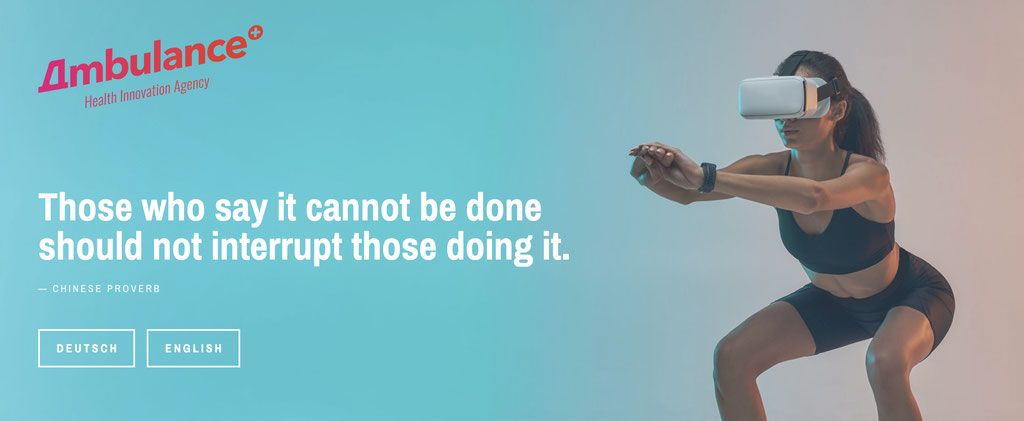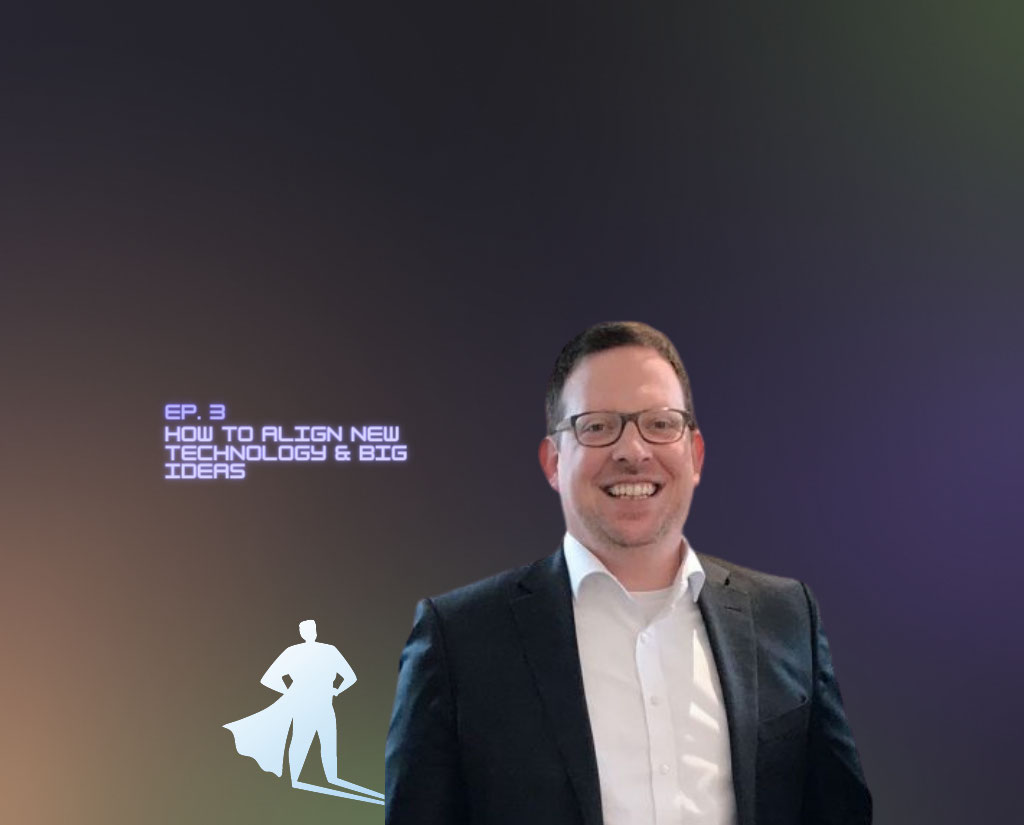
Innovation Heroes: Season 3 - Episode. 3
Tech is evolving exponentially along with the demand for innovation—especially when it comes to moving healthcare forward. We sat down with Julian Weinert of AMBULANCE Health Innovation Agency to get the details on how he creates alignment between his company's big ideas and ever-changing technology. The potential for tech and innovation to rapidly transform the healthcare industry has the potential to improve patient outcomes and save lives.
What is Having the Greatest Impact?
The conversation narrows in on many advancing areas including AI and "Automotive health" - a term used to describe the integration of healthcare technology with the automobile industry. Adam and Julian also explore how fostering partnerships and internal buy-in promotes collaboration and teamwork among healthcare professionals leading to better patient outcomes. Collective problem-solving approaches such as design thinking and agile methodologies can help organizations iterate quickly and find solutions to complex problems. Together, these factors are driving innovation in healthcare.
🔉 Click to listen 👇
Highlights from Season 3: Episode 3
Here, we've pulled some highlight excerpts from our interview with Julian--tune in to the full episode.
Ambulance Health Innovation Agency: Moving Healthcare Forward
I've been present or active in the health sector for a little bit more than 20 years now, and I founded AMBULANCE five years ago, mostly with a focus on innovation in the health sector. Before that, I worked mainly in the healthcare marketing segment and realized that for most of my clients in this field, it's more interesting to get to know how the game changes in the future, and to know the relevant tricks you need to stay one step ahead of the competition. Five years ago, I did not know what I opened up with this, and a lot of strange and interesting projects came along the way. It's really interesting because we support clients from ideation creation, like the first step in what we can do, all the way through to R&D.
Staying Ahead of the Curve
We make a prognosis like a staircase model. We say--okay--what are the next steps you have to climb to reach some point in the future, and then we look at it to where we can identify clear cases where we see that there are not many other possible scenarios. When we see that it's obvious that a scenario becomes realistic in a few years, then we can make a prognosis and say OK, why don't we follow step by step?
This is where we usually try to convince our clients if they aren't convinced already. This is so very complex in some cases--what does it take to make innovation happen? What we try to do is when we enter a field where no one has been before globally, which in some cases is the case, we try to identify the person or people that have experience in the nearby segment so that we have a project team that is very close and has the knowledge to enter this new field.
Why Relationships Matter
We leverage a lot of expert relationships, you know, when we're pitching on our FPs or putting together high-level proposals. We're kind of playing in areas where we're not so confident, so being able to have those experts kind of on our team, it definitely helps to get that internal buy-in. There's so many levels of internal buy-in you have to get, and anything you can do to move that along and get some level of confidence within the organization is certainly a benefit.
Ambulance Health Innovation: Spotlighting Rare Diseases
One thing we're working on right now is trying to identify scenarios and solutions to improve rare disease diagnostics. Let's say as an example, in Germany for many patients, it's very hard to get diagnosed correctly when you have a rare disease. Like one in 100,000 cases, for example, it's so complex, and physicians say they don't know what disease it could be, so they try to treat a different disease, and the second step works to see whether the disease is a rarity. We work on identifying technology solutions that could help diagnose rare diseases earlier. We have several projects on digital biomarkers--we identify algorithms that are able to detect various diseases or identify treatments.
What's the hype with Automotive Health? As cars become increasingly connected, they can collect and share vast amounts of data about the driver's health and wellness, including heart rate, blood pressure, and respiratory rate. This data can be analyzed to provide real-time feedback to drivers and even alert medical professionals in the event of a health emergency. This innovation has the potential to transform healthcare by enabling early detection and intervention of health issues while also improving overall patient outcomes. The concept of automotive health is quickly becoming a significant trend in the future of healthcare!
How AI Is Changing Health Technology
When COVID started in Germany, we had to test ourselves several times and get certificates to be able to leave the house and meet with other people. More and more people disliked the process, so we came up with the idea of an automated process that makes it easier with a medical device that doesn't require a trip to a test center. We realized there are companies in Germany that have a pattern and solution for breath gas analyzers that analyze whether a person has COVID. They validated that the breath gas analyzers were the same quality as a lab test.
We thought we could implement something like this into a vehicle that cycles the air inside several times. The detection system can come to a negative result and the vehicle could send the negative certificate to a smartphone. It was just an idea, but it's a realistic case. Even though we're too late for the COVID scenario, we realized this technology is capable of detecting other molecules besides COVID.
From Start to Finish: The Innovation Process at Ambulance
We have some clients that jump in at a later stage, but we also have clients that jump in from a very early stage. In some cases, they do not finish the path with us. For example, there are cases where we see the knowledge we can bring in and also the project management leaders necessary for success, and we see that we're not likely to have relevant success.
When we decide to move forward, most projects take two to three years. Let's say we're doing medical device development--sometimes it can take longer when we have clinical trials or other things that need to be done. In one case, we tested factors of in vitro testing where we analyze cases, then go to animal testing, which is becoming more and more difficult, but is needed in some cases. We then move forward to human testing, and so on. It's complex, but in most cases, the decision to make an innovative project needs to happen from the beginning.
I rarely have cases where the client says they want to do the innovative thing, then somewhere on the way decides they're not sure anymore. I don't think we ever had that case--most of the time the decision must happen in the beginning. We try to show the whole case until the final product that we propose in the strategy and then make steps forward. Most of the projects are really long-term projects.
Collective Problem Solving
We workshop with the customers of the client, whether it's physicians or patients. Then, we identify realistic ideas that the client can bring to life. In some cases where there is, for example, a ridiculous-sounding idea that's coming out, we pitch the idea to universities and say ok, what kind of approach do you have? Is there someone in your team with the expertise to solve the problem? Then, they come up with their solution, and might become part of the project.
The Future is Collaborative
Aligning new technology with big ideas requires a thoughtful and strategic approach. By focusing on the potential impact of new technologies, building a team with diverse expertise, having a clear strategy for implementation, embracing experimentation and failure, and staying up-to-date with emerging trends, businesses and individuals can harness the power of new technology to achieve their biggest goals and create meaningful change.
Thank you for checking out Season 3: Episode 3 of the Innovation Heroes series!
Let's keep the conversation going! Interested in chatting with Adam on an Innovation Heroes segment or recommending a guest? To join the queue, send an email to possibilities@herox.com Attn: Adam. Include your name, email, and topic of interest (you can also use the HeroX contact form).

About Julian Weinert | Connect
Digitalizing Health - since 1996, Julian knows the payor and insurance side from various projects as well as the Big Pharma and Med-Tech sector. From innovative and successful Marketing and Product Launch Strategy projects to innovation strategies, cultural change projects and founding of new companies for clients he is experienced in making new things happen.
Connect with Julian: LinkedIn

🔉 About the Innovation Heroes podcast
The Innovation Heroes series covers all things open innovation, crowdsourcing, and remote work. It’s time to open up the airways, share strategies, engage partners, and leverage the power of crowd intelligence to expedite solutions to the pressing problems facing every level of organization, individuals, and the world. The key word here is OPEN.
We're bringing our partners in innovation, organizations who have run their own crowdsourcing projects, innovator powerhouses, and remote work legends into the spotlight. There is a global network ready to contribute time, energy and intelligence to just about any challenge that comes their way. All we need to do is provide the opportunity. Thank you for being a part of the solution. Discover the Power of the Crowd.
About Adam Olsen | Connect
Adam is your Podcast Host and Possibilities Manager at HeroX, connecting with innovation leaders from around the world to gain insights on how they approach innovation, the technologies they're most excited about, and how these innovations impact their industries.
HeroX is a platform and open marketplace for crowdsourcing innovation that allows anyone, anywhere, to solve everyday business and world challenges using the power of the crowd.
Connect with Adam: LinkedIn,
www.HeroX.com Innovation Heroes © 2021 - Your Crowd. Your Solution.








